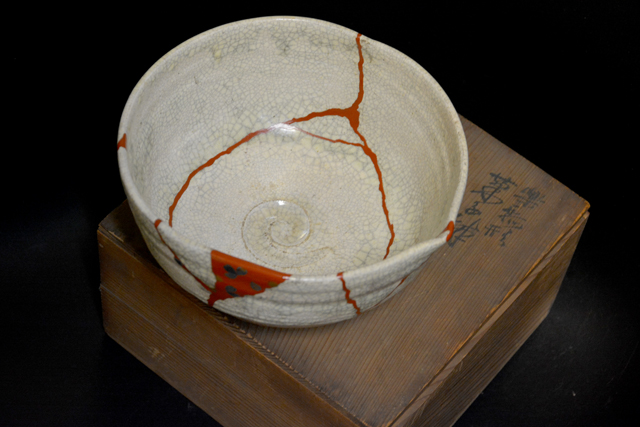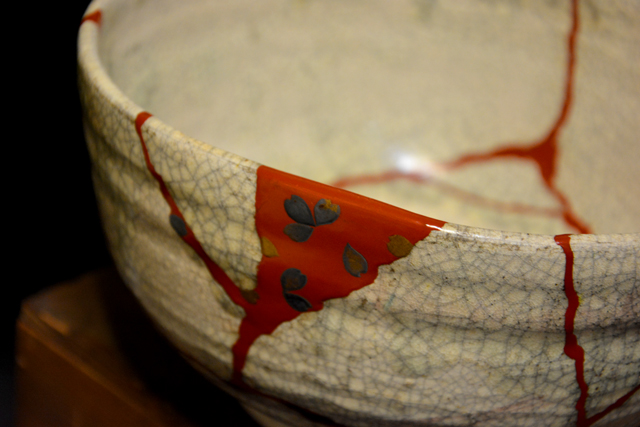2016.10.28
Mizusashi [water container] of Unknown Master of Tea Ceremony

It was as if it had meandered like driftwood from a distant island,
never revealing the identity of its original owner,
drifting through the great ocean of modern distribution,
finding its way into my presence.
Many tea ceremony and antique pieces that circulate the market follow a similar path, erasing any recollection of its past owners as they are passed on to the hands of the next merchants, tea masters and collectors.
This piece that came to me as a tea ceremony tool called a mizusashi
looks quite odd compared to your traditional mizusashi.
Its form has no depth and the mouth is wide.
Clearly it does not have the traditional cylindrical shape, or anything close in terms of height or width.
Of course, it is not the only mizusashi of its kind in the world. However,
“Hmm… What is this?” is the kind of reaction most tea masters would undoubtedly have upon seeing it.
Upon seeing the calligraphy on the old, dust-covered tomobako [signed wooden boxes in which ceramic pieces are stored], its form would receive the reaction, “I see. Now I understand.”

It reads, “Kashibachi” [sweets bowl]. Yes. This mizusashi was originally created as a bowl for sweets.
An unknown tea master…
The more and more I looked at the bowl, the more and more deeply I wondered how much adoration he must have felt for this piece.
Fragments of the kashibachi were collected, their mending entrusted to a skilled craftsman.
Kintsunagi [gold mending] would have been gaudy. Shuurushi [vermilion lacquering] alone would have been too understated.
Thus, beautiful gold and silver cherry blossom petals were used to conceal missing shards.
Oxidation has caused the silver to turn to gray, but
the way it contrasts with the vermillion lacquer produces a truly wonderful quality in the piece.
Extraordinary aestheticism.
It’s quite strange, but when I saw this piece, it conjured images of mummies in the ancient Egyptian tombs of pharaohs.
In ancient Egypt,
with complete devotion to the king and the resurrection of his soul in the afterlife,
great care was taken in preparing the mummy.
Lamenting the shattering of the kashibachi that had become merely a collection of broken pieces,
and pondering how it could once again be made beautiful,
now, it has once again taken form as an odd, yet indescribably beautiful mizusashi.

Its “rank” as a tea ceremony tool unfortunately falls, and when the damage is this severe,
the value also presumably falls considerably. However, “So what?” is what I think.
In the world of tea, the mere flicks of a brush upon a box by a person of repute will increase the market value of a piece many times over.
The successive generations of ceramic artists are not always accompanied by discipline and craftsmanship, thus
a tea bowl in a box adorned with a genuine signature continues to be highly valued.
And that should not necessarily be considered a bad thing.
It goes without saying that good pieces are good, and it is through just such a value system that
tradition is born, and the wonderful world of tea tools forever continues maintaining a wide base.
The main problem is that, if we view things on a monetary scale,
our sense of aesthetics and adoration is lost.
Just because a perfect piece made by an unknown ceramic artist does not exist, nor does there exist an accompanying tomobako,
a perfect piece made by a former master craftsman is thought of as worthless.
The world of ceramic arts is incredibly deep.
Nevertheless, the moment that I come across a “good piece” that slightly veers from the vector of worldly values,
and from which I can feel the beauty and romanticism placed upon the piece by not only the craftsman, but the user as well,
there emerges the indescribable sense of value and excitement of, none other than, the love of a “good piece”.






